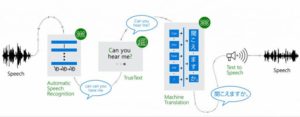This week’s blog post on digital accessibility is focusing on how artificial intelligence can impact and improve digital accessibility for individuals with disabilities. What is artificial intelligence? Artificial intelligence (AI) also known as machine intelligence is intelligence demonstrated by a machine (Poole, et al., (1998).
(A picture of Watson by IBM).
The most readily identifiable AI on the planet is probably Watson by IBM. A super computer that has true artificial intelligence and has been used on a variety of tasks including ones that would not normally be able to be completed by a machine. Watson is not only capable of AI but is constantly learning new things. Through the power of Watson it is completed by extraordinary challenges such as beating the best chess players on the planet.
A cartoon style picture of a gentleman with a cane being assisted by a robot across the street
Artificial intelligence is already being utilized to support the sensory impaired, namely the deaf/HOH community and those in our community with blindness. In the United Kingdom (UK), Her Majesty’s government requires that websites meet success criteria level AA of the WCAG. The actual requirement for sign language provision is an AAA requirement based on the WCAG success criteria so it is exceptionally difficult for most websites to meet this standard. Especially, as sign language would be needed for all multimedia and this is where artificial intelligence could be utilized to potentially view, assess and then translate the media into sign language in almost real-time to the website user with who is deaf/HOH.
An infographic on AI by Micosoft that explains how AI work with speech translation and captioning.
Currently, AI is being utilized by Microsoft in the form of a free service through the Microsoft Translator application where spoken word can be translated into a variety of languages including the provision of text (captions). In one of my prior roles for the State of Maryland I utilized this very tool when working with members of the deaf community. It allowed me to get my message to the individual with a hearing impairment when an interpreter was not available at that exact time. I could speak my message and it real-time captioned my words for the consumer to review.
Finally, based on the current and growing use of AI in the world, I foresee the power of AI being a part of many future accessibility blog posts!
Poole, David; Mackworth, Alan; Goebel, Randy (1998). Computational Intelligence: A Logical Approach. New York: Oxford University Press. ISBN 978-0-19-510270-3.


